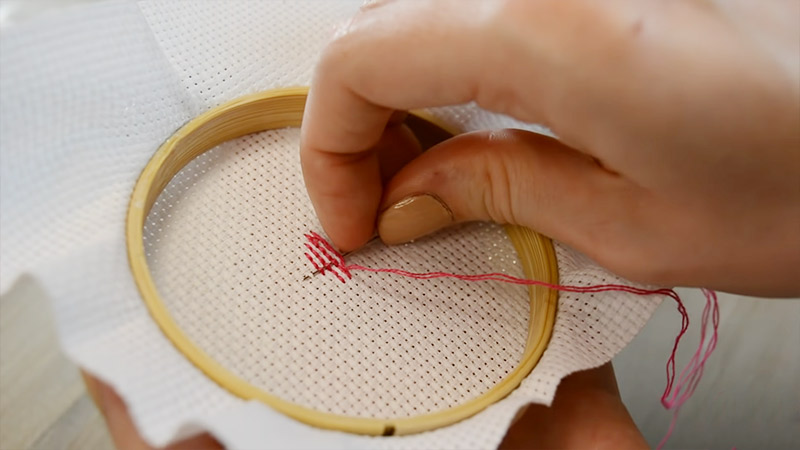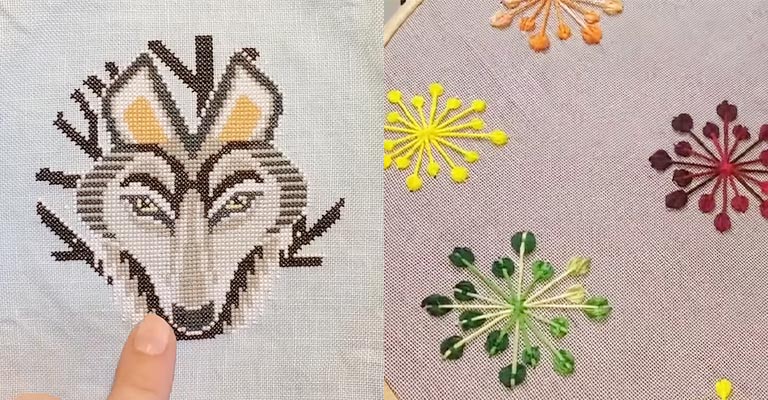Embroidery and crossstitch are two popular needlecraft techniques, both celebrated for their intricate designs and timeless appeal.
Yet, when it comes to the question of complexity, one stands out as a more challenging endeavor: embroidery.
The world of embroidery is a rich tapestry of diverse stitches, artistic expressions, and intricate patterns.
It demands a broader skill set, from mastering an array of stitches to creating original designs.
In contrast, cross stitch, while equally captivating, relies on a single, straightforward stitch and predetermined patterns.
In this exploration, we will delve into the reasons why embroidery is often perceived as a more demanding craft than cross stitch, shedding light on the artistry and intricacies of both.

Is Embroidery Harder Than Cross Stitch?
Yes, embroidery is generally considered to be more challenging than cross stitch.
Here are the reasons why embroidery is harder than cross stitch:
Variety of Stitches
Embroidery offers a vast array of stitches that can be intimidating for beginners. Some stitches are relatively simple, like the running stitch, while others are considerably more complex, such as the intricate thread-wrapping techniques of crewel embroidery.
Each stitch requires precise execution and an understanding of how to manipulate the thread, which can be overwhelming for those new to the craft.
In contrast, cross stitch relies on just one basic X-shaped stitch, making it easier for beginners to grasp.
Creativity and Design
An embroidery is a form of artistic expression where the embroiderer often has to decide on the design, color choices, and how to bring their vision to life.
This creative aspect adds a layer of complexity as it demands artistic skills, a good eye for aesthetics, and an understanding of how colors and textures work together.
Cross stitch, conversely, is more like a paint-by-numbers approach, as the pattern dictates the colors and stitches to be used.
Complexity of Patterns
Embroidery patterns can vary widely in terms of complexity. More intricate patterns may include a mix of stitches and techniques like satin, chain, or couching stitches.
Additionally, shading and layering are often employed in embroidery, making it more challenging to interpret the design and achieve the desired effect.
In contrast, cross-stitch patterns are typically straightforward to follow since they’re based on a grid system where each square represents a single stitch.
Versatility of Materials
Embroidery involves working on various materials, each with its unique properties. For example, working on fine silk versus heavy canvas requires different techniques and a deep understanding of fabric behavior.
Cross stitch primarily utilizes even-weave fabrics like Aida or linen and standardized embroidery floss, simplifying the material aspect and allowing for more consistency.
Precision and Attention to Detail
In embroidery, precision is crucial. Mistakes can be more challenging to correct because unraveling stitches might damage the fabric or leave visible marks.
In cross stitches, errors can be undone and corrected more easily, making it more forgiving, especially for beginners. This aspect of embroidery demands patience, attention to detail, and a steady hand.
Advanced Techniques
Embroidery offers a vast world of advanced techniques that go beyond the basics. Stumpwork, for instance, involves creating three-dimensional embroidered elements, and goldwork incorporates metal threads for intricate embellishments.
Needle painting simulates brush strokes in traditional painting using stitches. These advanced techniques require a significant amount of practice and dedication to master, taking embroidery to a whole new level of complexity.
Cross stitch, by contrast, primarily stays within the realm of counted thread work and doesn’t have the same depth of specialized techniques.
What Is the Difference Between Cross Stitch and Embroidery?

Cross stitch and embroidery are two distinct forms of needlework, each with its unique characteristics.
The main differences between them lie in their stitching techniques, patterns, materials, threads, precision, and overall complexity.
Here’s a breakdown of the key differences between these two art forms:
Stitching Technique
- Cross Stitch: Cross stitch is characterized by the use of X-shaped stitches to create a design. This stitch is made by crossing two threads over each other at a 90-degree angle, typically on even-weave fabric.
- Embroidery: Embroidery encompasses a wide range of stitching techniques. It involves various stitches like backstitch, satin stitch, chain stitch, and more. These stitches create intricate patterns and designs, and embroiderers often have more creative freedom in choosing the appropriate stitches for their projects.
Patterns and Designs
- Cross Stitch: Cross-stitch patterns are usually charted on a grid. Each square on the grid corresponds to a single cross stitch. These patterns are often geometric and can represent pixel-like images or intricate scenes.
- Embroidery: Embroidery patterns can be highly diverse and artistic. They range from intricate florals and wildlife to freeform designs. Embroiderers can use a combination of stitches to create textures, shading, and depth in their work.
Materials
- Cross Stitch: Cross stitch is typically done on even-weave fabrics such as Aida cloth or linen. The stitches are evenly spaced and easy to count.
- Embroidery: Embroidery can be done on a wide variety of fabrics, including but not limited to, cotton, silk, denim, and more. The choice of fabric can greatly impact the final appearance of the project.
Threads
- Cross Stitch: Cross stitch primarily uses embroidery floss, which is a divisible thread made of six strands twisted together. Embroidery floss is typically consistent in thickness.
- Embroidery: Embroidery uses a wide array of threads, including floss, perle cotton, metallic threads, and specialty threads. These threads come in different thicknesses, textures, and finishes, allowing for more versatility in design.
Precision
- Cross Stitch: Cross stitch is highly structured and relies on precision to create even clean designs. The stitches are uniform in size and shape.
- Embroidery: Embroidery often involves more freehand work, which allows for creative expression but may require a steadier hand and greater attention to detail.
Difficulty
- Cross Stitch: Cross stitch is generally considered easier to learn, making it an excellent choice for beginners due to its repetitive and straightforward technique.
- Embroidery: Embroidery is often seen as more complex because of its wide range of stitches and creative demands, making it a bit more challenging for beginners.
FAQS
Are the materials used for cross stitch and embroidery the same?
While both crafts may use similar materials like fabric and thread, the choice of fabric and threads can vary.
Cross stitch often involves even-weave fabrics and standardized embroidery floss, while embroidery utilizes a wider range of fabrics and threads.
Can you convert a cross-stitch pattern into an embroidery design or vice versa?
Converting patterns between cross stitch and embroidery may be possible, but it requires adapting the design to suit the different techniques and stitch styles.
Are there any hybrid techniques that combine elements of both cross stitch and embroidery?
Yes, some crafters explore hybrid techniques that incorporate elements of both crafts.
For example, a project might involve a cross stitch for the main design and embroidery for added embellishments and details.
Is cross stitch less time-consuming than embroidery?
Cross stitch is often considered less time-consuming because of its repetitive nature and straightforward stitches.
However, the time required for both crafts depends on the complexity of the design and the stitcher’s skill level.
Can cross stitchers easily transition to embroidery, or vice versa?
Cross stitchers can often transition to embroidery with relative ease, as many embroidery stitches are based on the same principles.
The transition from embroidery to cross stitch may also be smooth, but it might take some adjustment to the simpler technique and grid-based designs.
Last Words
The debate over whether embroidery is harder than cross stitch reveals the diverse and captivating world of needlecraft.
While both crafts offer unique artistic outlets, embroidery tends to be viewed as the more challenging of the two.
Its intricate stitches, creative freedom, varied materials, and complex designs provide an enriching but demanding experience.
Cross stitch, by contrast, offers a simpler, more structured approach, making it an excellent choice for beginners.
Ultimately, the choice between these crafts depends on individual preferences, artistic ambitions, and the desire for either the precision and discipline of cross stitch or the creative complexity of embroidery.
Regardless of the path chosen, both crafts are celebrated for their beauty and enduring charm.
Leave a Reply